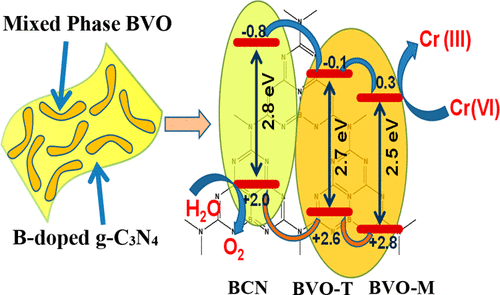当前位置:
X-MOL 学术
›
Inorg. Chem.
›
论文详情
Our official English website, www.x-mol.net, welcomes your
feedback! (Note: you will need to create a separate account there.)
Serendipitous Assembly of Mixed Phase BiVO4 on B-Doped g-C3N4: An Appropriate p–n Heterojunction for Photocatalytic O2 evolution and Cr(VI) reduction
Inorganic Chemistry ( IF 4.3 ) Pub Date : 2019-08-28 00:00:00 , DOI: 10.1021/acs.inorgchem.9b02309
Pradeepta Babu 1 , Satyaranjan Mohanty 1 , Brundabana Naik 1 , Kulamani Parida 1
Inorganic Chemistry ( IF 4.3 ) Pub Date : 2019-08-28 00:00:00 , DOI: 10.1021/acs.inorgchem.9b02309
Pradeepta Babu 1 , Satyaranjan Mohanty 1 , Brundabana Naik 1 , Kulamani Parida 1
Affiliation

|
Type II p–n heterojunction B-doped g-C3N4/BiVO4 moieties have been fabricated by depositing n-type BiVO4 on the surface of p-type 1 wt % B-doped g-C3N4 for the first time. The materials were characterized by PXRD, XPS, UV–vis DRS, IR, PL, and Raman analysis. The photocatalytic activities of as synthesized samples were studied toward reduction of Cr(VI) and water splitting reaction to generate oxygen. The results reveal that Type II p–n heterojunction considerably enhance the photocatalytic activity as compared to neat n-type BiVO4 and p-type B-doped g-C3N4. 50% BiVO4/B-doped g-C3N4 heterostructure exhibited the best photocatalytic activity, which is 7.9-fold higher than that of BiVO4 and followed by a pseudo first order kinetics with apparent first order rate constant of 0.063 min–1. Again the heterojunction is able to produce 4.2 times higher oxygen evolution value as related to pristine BiVO4. The superior photocatalytic activity is attributed to higher visible light utilization and lower recombination of electron–hole pairs by creating a p–n junction. PXRD and HRTEM data suggest the formation of mixed phase monoclinic and tetragonal BiVO4 thereby creating a heterojunction for the improvement of the photocatalytic performances. The formation of mixed-phase BiVO4 is attributed to the high temperature calcination as well as surface energy of B-doped g-C3N4. The oxygen vacancy in the system is confirmed through XPS and Raman analysis. Moreover, the excellent photocurrent response by the designed photocatalyst at lower overpotential and decrease in carrier recombination as compared to bulk one, studied from LSV and electrochemical impedance spectroscopy, validate the unique photocatalytic activity of the catalyst. The formation of the p–n heterojunction is confirmed from a Mott–Schottky analysis. The work shed new light on the assembly of the p–n heterojunction, showing excellent photocatalytic properties in a simple way.
中文翻译:

混合相BiVO的偶然大会4上B掺杂GC 3 Ñ 4:合适的p-n异质结光催化Ò 2演化和Cr(VI)还原
II型p–n异质结B掺杂的gC 3 N 4 / BiVO 4部分是通过在p型1 wt%B掺杂的gC 3 N 4的表面上首次沉积n型BiVO 4来制造的。通过PXRD,XPS,UV-vis DRS,IR,PL和拉曼分析对材料进行了表征。研究了作为合成样品的光催化活性对Cr(VI)的还原和水分解反应生成氧气的作用。结果表明,与纯n型BiVO 4和p型B掺杂的gC 3 N 4相比,II型p–n异质结大大增强了光催化活性。50%BiVO 4 / B掺杂的gC3 N 4异质结构表现出最佳的光催化活性,比BiVO 4高7.9倍,其次是拟一级动力学,其一级速率常数为0.063 min –1。同样,异质结能够产生比原始BiVO 4高4.2倍的氧释放值。优异的光催化活性归因于通过创建ap-n结而提高了可见光利用率,并降低了电子-空穴对的重组。PXRD和HRTEM数据表明形成了混合相单斜和四方BiVO 4,从而产生了异质结以改善光催化性能。混合相BiVO的形成图4的结果归因于B掺杂的gC 3 N 4的高温煅烧以及表面能。通过XPS和拉曼分析确认系统中的氧空位。此外,通过LSV和电化学阻抗谱研究,与本体1相比,所设计的光催化剂在较低的过电势和载流子复合减少方面具有出色的光电流响应,证实了该催化剂独特的光催化活性。p–n异质结的形成已通过Mott–Schottky分析得到证实。这项工作为p–n异质结的组装提供了新的思路,并以简单的方式显示了出色的光催化性能。
更新日期:2019-08-28
中文翻译:

混合相BiVO的偶然大会4上B掺杂GC 3 Ñ 4:合适的p-n异质结光催化Ò 2演化和Cr(VI)还原
II型p–n异质结B掺杂的gC 3 N 4 / BiVO 4部分是通过在p型1 wt%B掺杂的gC 3 N 4的表面上首次沉积n型BiVO 4来制造的。通过PXRD,XPS,UV-vis DRS,IR,PL和拉曼分析对材料进行了表征。研究了作为合成样品的光催化活性对Cr(VI)的还原和水分解反应生成氧气的作用。结果表明,与纯n型BiVO 4和p型B掺杂的gC 3 N 4相比,II型p–n异质结大大增强了光催化活性。50%BiVO 4 / B掺杂的gC3 N 4异质结构表现出最佳的光催化活性,比BiVO 4高7.9倍,其次是拟一级动力学,其一级速率常数为0.063 min –1。同样,异质结能够产生比原始BiVO 4高4.2倍的氧释放值。优异的光催化活性归因于通过创建ap-n结而提高了可见光利用率,并降低了电子-空穴对的重组。PXRD和HRTEM数据表明形成了混合相单斜和四方BiVO 4,从而产生了异质结以改善光催化性能。混合相BiVO的形成图4的结果归因于B掺杂的gC 3 N 4的高温煅烧以及表面能。通过XPS和拉曼分析确认系统中的氧空位。此外,通过LSV和电化学阻抗谱研究,与本体1相比,所设计的光催化剂在较低的过电势和载流子复合减少方面具有出色的光电流响应,证实了该催化剂独特的光催化活性。p–n异质结的形成已通过Mott–Schottky分析得到证实。这项工作为p–n异质结的组装提供了新的思路,并以简单的方式显示了出色的光催化性能。

































 京公网安备 11010802027423号
京公网安备 11010802027423号